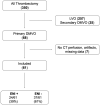Early Neurological Improvement Predicts Clinical Outcome After Thrombectomy for Distal Medium Vessel Occlusions
- PMID: 35321507
- PMCID: PMC8936066
- DOI: 10.3389/fneur.2022.809066
Early Neurological Improvement Predicts Clinical Outcome After Thrombectomy for Distal Medium Vessel Occlusions
Abstract
Background and purpose: Good clinical outcome predictors have been established in mechanical thrombectomy (MT) for acute ischemic stroke (AIS) caused by large vessel occlusion (LVO). An early neurological improvement (ENI), defined as a reduction of ≥8 on the National Institutes of Health Stroke Scale (NIHSS), compared with the baseline score or an NIHSS of 0 or 1 at 24 h after MT, is a strong predictor of favorable outcome. We aimed to study the impact of ENI after MT for distal medium vessel occlusions (DMVO).
Methods: We retrospectively analyzed the data of consecutive patients who underwent MT for a primary DMVO in one large academic center. We compared clinical outcomes between patients with DMVO stratified by ENI. Multivariate analyses were performed to determine the impact of ENI on good 90-day outcome (modified Rankin scale of 0-2) and identify factors contributing to ENI.
Results: Between January 2018 and January 2021, 61 patients underwent an MT for an AIS with a primary DMVO. An ENI was seen in 24 (39%) patients (ENI+). Outcomes were significantly better in ENI+ patients, with 83% achieving a good outcome at 3 months vs. 43% for patients without ENI (ENI-; p = 0.019). ENI was an independent predictive factor of good clinical outcome even after adjusting for potential confounding factors [odds ratio 12.49 (1.49-105.01), p = 0.020]. The use of intravenous tissue plasminogen activator [IVtPA; Odds-ratio 6.59 (1.82-23.89), p = 0.004] was a positive predictor of ENI.
Conclusion: ENI at day 1 following MT for DMVO stroke is a strong independent predictor of good to excellent 3-month clinical outcome.
Keywords: distal thrombectomy; endovascular recanalization; intravenous thrombolysis; prediction; stroke.
Copyright © 2022 Wang, Farouki, Hulscher, Mine, Bonnet, Elens, Vazquez Suarez, Jodaitis, Ligot, Naeije, Lubicz and Guenego.
Conflict of interest statement
The authors declare that the research was conducted in the absence of any commercial or financial relationships that could be construed as a potential conflict of interest.
Similar articles
-
Neurological improvement predicts clinical outcome after acute basilar artery stroke thrombectomy.Eur J Neurol. 2021 Jan;28(1):117-123. doi: 10.1111/ene.14487. Epub 2020 Sep 17. Eur J Neurol. 2021. PMID: 32812674
-
Predictors of Good Clinical Outcome after Thrombectomy for Distal Medium Vessel Occlusions.World Neurosurg. 2022 Apr;160:e566-e572. doi: 10.1016/j.wneu.2022.01.067. Epub 2022 Jan 22. World Neurosurg. 2022. PMID: 35077884
-
Predictors of Early Neurological Improvement and Its Relationship to Thrombolysis Treatment and Long-Term Outcome in the WAKE-UP Study.Cerebrovasc Dis. 2023;52(5):560-566. doi: 10.1159/000528805. Epub 2023 Mar 2. Cerebrovasc Dis. 2023. PMID: 36863328 Clinical Trial.
-
Early neurological improvement as a predictor of outcomes after endovascular thrombectomy for stroke: a systematic review and meta-analysis.J Neurointerv Surg. 2023 Jun;15(6):547-551. doi: 10.1136/neurintsurg-2022-019008. Epub 2022 May 30. J Neurointerv Surg. 2023. PMID: 35636948
-
Common design and data elements reported in active mechanical thrombectomy trials focusing on distal medium vessel occlusions and minor strokes: a systematic review.J Neurointerv Surg. 2024 Jan 11;17(5):530-538. doi: 10.1136/jnis-2023-021073. J Neurointerv Surg. 2024. PMID: 38212110
Cited by
-
Predictors of failure of early neurological improvement in early time window following endovascular thrombectomy: a multi-center study.Front Neurol. 2023 Sep 14;14:1227825. doi: 10.3389/fneur.2023.1227825. eCollection 2023. Front Neurol. 2023. PMID: 37780716 Free PMC article.
-
Effects of glycemic indicators on early neurological outcomes in patients with acute ischemic stroke treated with intravenous thrombolysis.World J Diabetes. 2025 Mar 15;16(3):94491. doi: 10.4239/wjd.v16.i3.94491. World J Diabetes. 2025. PMID: 40093278 Free PMC article.
-
Factors associated with oropharyngeal dysphagia and unsuccessful nasogastric tube removal after endovascular thrombectomy for anterior circulation stroke.Eur Geriatr Med. 2024 Dec;15(6):1669-1681. doi: 10.1007/s41999-024-01069-9. Epub 2024 Sep 24. Eur Geriatr Med. 2024. PMID: 39317881
-
Identifying the predictors of ultra early neurological improvement and its role in functional outcome after endovascular thrombectomy in acute ischemic stroke.Front Neurol. 2025 Jan 31;16:1492013. doi: 10.3389/fneur.2025.1492013. eCollection 2025. Front Neurol. 2025. PMID: 39958613 Free PMC article.
-
Mechanical Thrombectomy for Treatment of Acute Cerebral Infarction due to Distal Medium Vessel Occlusions: A Retrospective Cohort Study.Brain Behav. 2024 Nov;14(11):e70119. doi: 10.1002/brb3.70119. Brain Behav. 2024. PMID: 39508459 Free PMC article.
References
LinkOut - more resources
Full Text Sources


